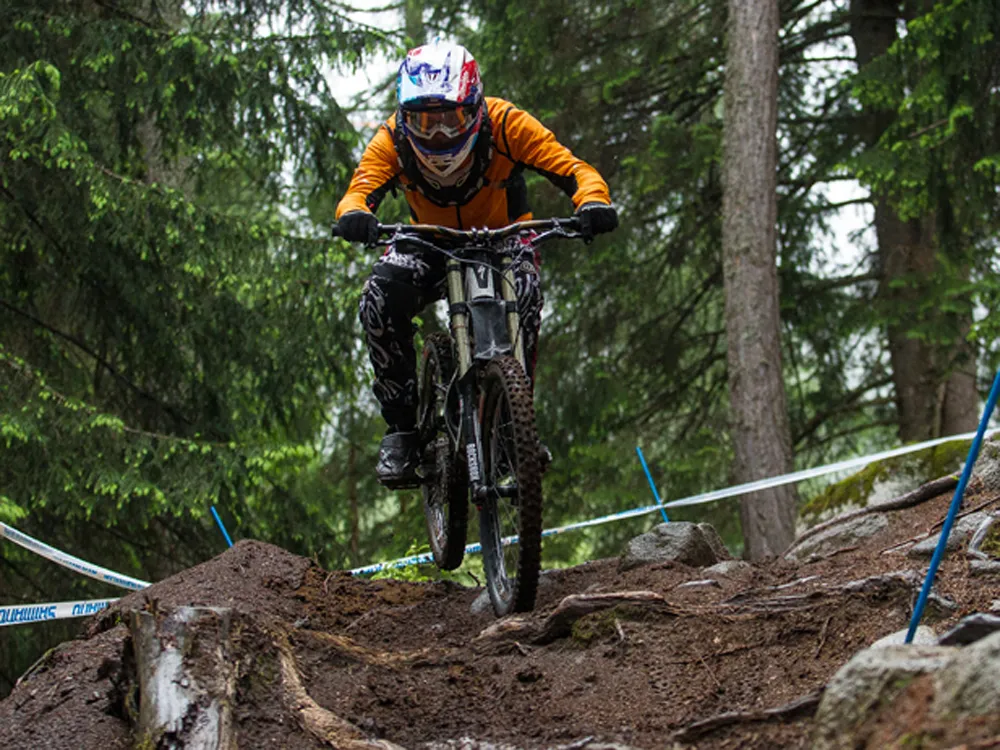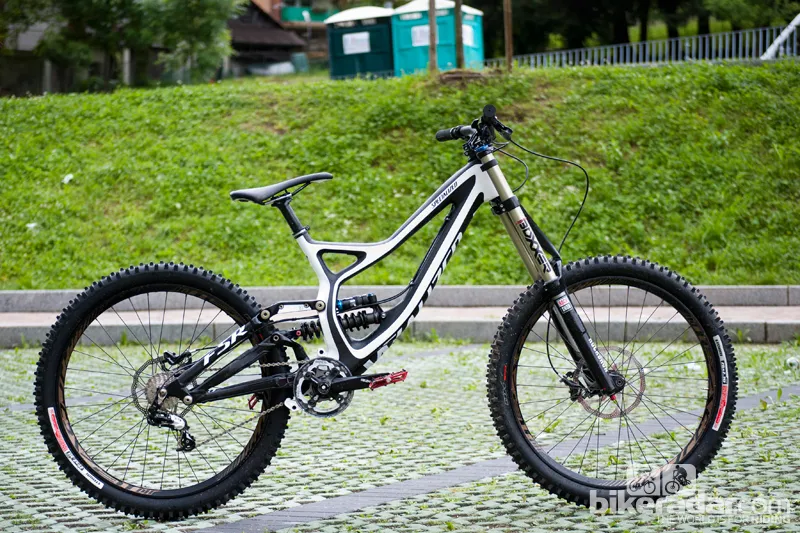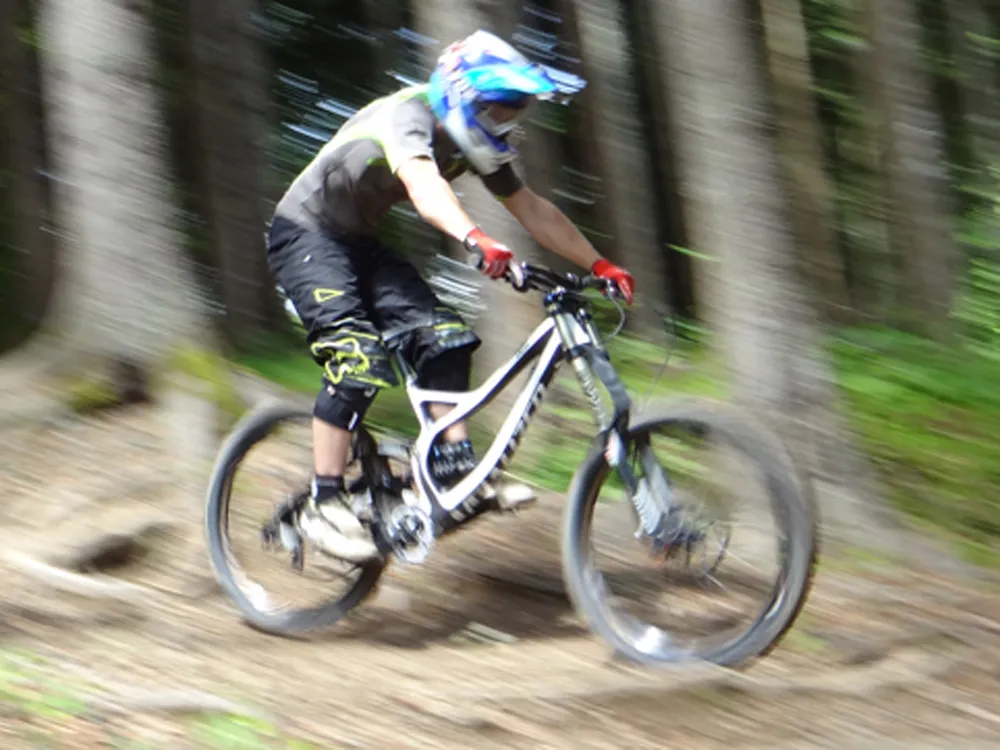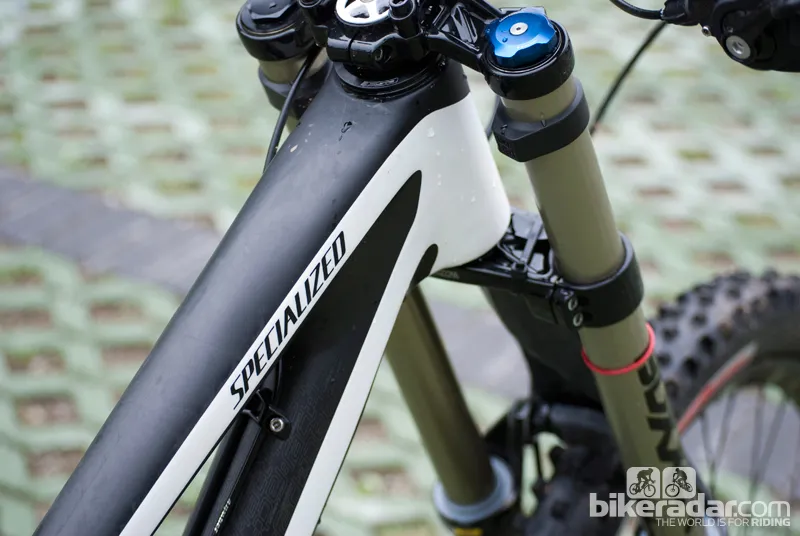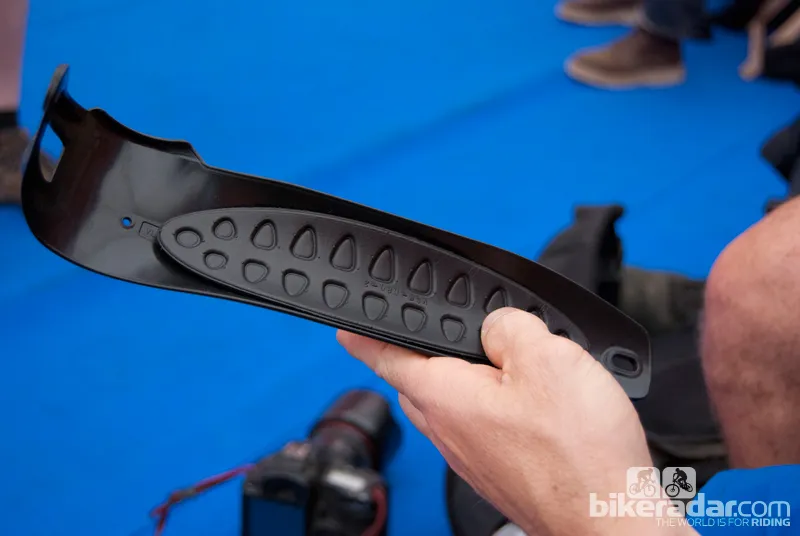After the recent launch of the Carbon Demo 8 at the world cup in Val di Sole, BikeRadar managed to persuade the big S to let us take the bike down to Morzine, France. There, we were able to give it a good hammering, and see just what the Demo 8 is all about.
Ride & handling: Immense, confident fun over the rough stuff
The first ride we had on the Demo was down a pretty wet and blown-out Val di Sole world cup track. Straight away, even in some pretty bad conditions, the bike behaved itself incredibly well. Straight to Morzine to get some proper time in, then…
For a race bike, there’s a serious amount of fun to be had on the Demo. Its short (421mm) rear end makes for some monumental turning speed, and the suspension complements it perfectly, being able to carry that speed forwards out of a turn rather than get bogged down in it.
Also contributing to the silly cornering is the ground-hugging, 338mm bottom bracket height. It really is low, so the 32t chainring on the Team Replica bikes makes a lot of sense. The drop in height is easy to feel compared to the Alloy bike, even though there’s only about 5mm in it.
The bike really feels as though you sit into it, giving you the confidence to try gapping stuff up and bouncing off roots to try to make the next bit of downslope. When things do go wrong, the amazingly predictable FSR rear end saves the day. We managed to stay on over a couple of patches that left us gasping for breath. Think intertwined, rooty off-camber landings.
As with all the FSR linkage bikes, the suspension is amazingly predictable, and after a couple of runs you can be pretty sure about what the bike will do in any given situation. There are never any nasty surprises. As it goes, the Demo is an easy one to hop onto and give it some from. Even when it comes to stomping on the pedals there’s only a tiny amount of movement from the rear end. You don’t feel that there are any forces from the chain interfering with the travel.
When it comes to angles, the Demo really does work in harmony, and gives amazingly predicatble and easy handling. The 63-degree head angle doesn’t mean boring steering. Coupled with the low bottom bracket and short chainstays it results in the ability to get into corners early, tear up inside lines and rip through berms in a way that only a couple of other bikes we’ve ridden have ever allowed.
This bike doesn’t just excel in the corners though – that sit-in feeling and responsive handling means confidence just happens. Even through gnarly rock gardens and massive compressions in root sections, the bike just does it, with only a tiny amount of weight-shifting needed. The 17.02kg (37.5lb) weight doesn’t hinder its speed ability. Compared to the alloy rear, the carbon front end doesn’t unbalance the bike at all – it’s full gas, full time.
Frame & equipment: Light, stiff and with an excellent mix of parts
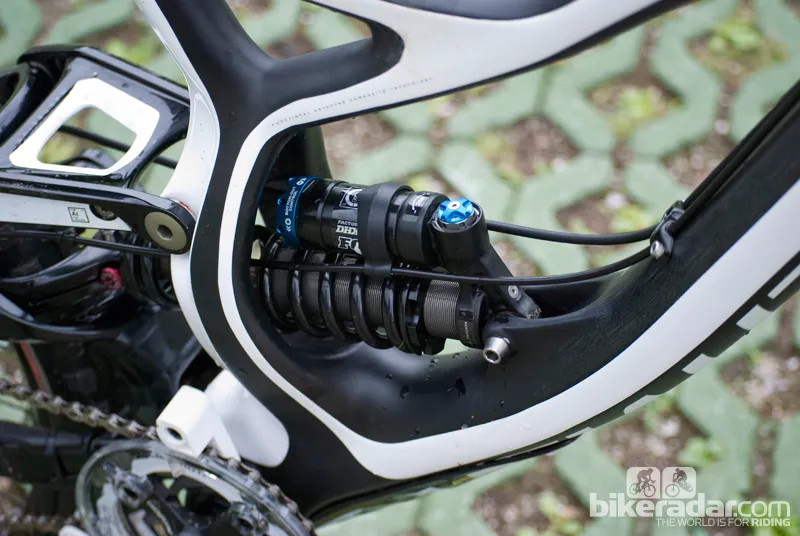
Fox's DHX RC4 rear shock
Specialized’s FSR suspension design doesn’t disappoint when it comes to the Demo. Compared to the Alloy bike, the shock’s top mount has been moved slightly to provide a more progressive suspension curve. This means there’s less shock fiddling needed to get the bike feeling exactly as it should.
When it came to spring weights, the spec did confuse us, with the fork spring too soft and shock spring too hard. It left us needing to change both – the soft spring to a medium in the fork, and the specced 400lb spring to a 350 on the shock.
Settings-wise though, only some minor fettling to the shock was needed. It was then left for the rest of the test, and we had absolutely no inclination to fiddle with it. All we did was up the pressure in the bottom-out chamber slightly, to 150psi. This helped increase that progression a little more towards the end of the shock’s stroke.
A carbon front triangle and alloy rear end make up the Demo’s frame. FACT 10M construction is the technical term for how they layer up the carbon. Every piece that goes into the smooth-looking front triangle is layered at a certain angle and in a certain place, ensuring that frames are consistent and have the exact amount of strength and stiffness that the designers wanted.
Jason Chamberlain, the main man behind the design of the Carbon Demo, explained to us how the aim was to create a lighter, stronger bike than the Alloy but maintain the same stiffness. This would allow the bike to track the ground in the way that it needs to, rather than it being too stiff, deflecting off objects on the trail and not being able to keep traction where needed.
The front triangle is made in two parts that are then bonded together, giving the designers even more input into exactly how the carbon is layered up. Once the frame is complete, the head tube and bottom bracket are graced with alloy inserts, giving massive durability increases over a carbon press-fit area. Yes, the bottom bracket is a press-fit – PF30DH to be exact. The massive CNC’d area incorporates ISCG tabs too, and we can’t see strength being a problem here.
Specialized have developed a down tube protector, too, different from most. It doesn’t sit against the frame, it sits away from it. Some shock-absorbing foam in the void means impact forces are absorbed far more effectively, and spread over a larger area rather than hitting big in one place.
When it comes to geometry, the new Carbon frame only sees one change from the Alloy model – a 5mm drop in bottom bracket height to a jaw-droppingly low 338mm. But this is still adjustable up to 343mm and 348mm with a simple cam in the rear shock mount. The head angle measures in at 63 degrees, with the top tube on our medium test bike at 580mm.
Of course, the Team Replica bike is the one everyone will be lusting after, but the basic Demo 8 is the bike that will be most available to the public, and definitely the most relevant. Its price is still to be announced, but expect it to be pretty reasonable compared to some of the other carbon-framed offerings out there.
The base model RockShox Boxxer is found up front, with adjustable rebound and compression damping. Out back you get the dial-tastic Fox DHX RC4. SRAM’s 10-speed X9 mech and X7 shifters, plus Shimano’s Tiagra 11-25t cassette, are powered through PF30 Descendant cranks not available aftermarket.
A Gamut P30 chainguide keeps the power on tap at all times. Contact points come from the Specialized stable, with their own DH saddle, 750mm wide bar and direct-mount stem. Attention to detail is second to none here – the stem has 5mm spacers installed underneath to provide extra rise, removable if needed.
Specialized’s new Bennies flat pedals come with the bike too. They’re top-notch, with no lack of grip thanks to their long pins and big bodies. The SIP grips are comfortable too. A fair bit of thought has obviously gone into them for downhill practicality – there’s no lock-on collar on the outside, with a thin but comfortable grip and a waffle on the underside. No stone has been left unturned by the big S.
